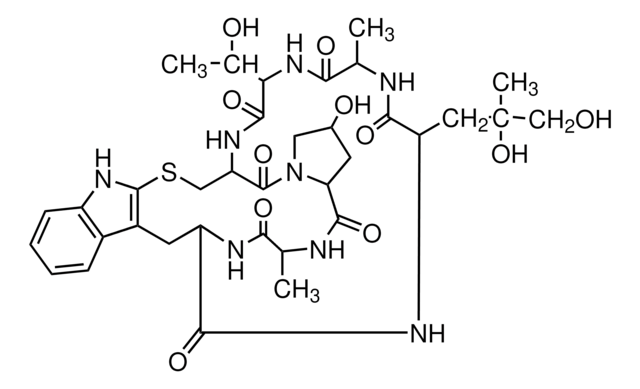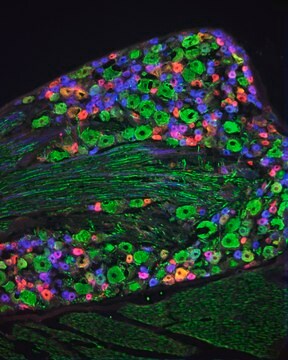P1951
Phalloidin Peptide
≥90% (HPLC), solid, TRITC labeled
Synonym(s):
Phalloidin-TRITC
Sign Into View Organizational & Contract Pricing
All Photos(2)
About This Item
Empirical Formula (Hill Notation):
C60H70N12O13S2
Molecular Weight:
1231.40
MDL number:
UNSPSC Code:
12352116
NACRES:
NA.32
Recommended Products
Product Name
Phalloidin–Tetramethylrhodamine B isothiocyanate, sequence from Amanita phalloides(synthetic: peptide sequence)
biological source
sequence from Amanita phalloides (synthetic: peptide sequence)
Quality Level
form
solid
fluorescence
λex 540-545 nm; λem 570-573 nm
storage temp.
−20°C
Related Categories
General description
Phalloidin is a phallotoxin produced by death cap mushroom Amanita phalloides. It is a cyclic peptide, which interacts with actin, and this was first identified in phalloidin-poisoned rats. It is a heptapeptide, cyclic in nature, with a crosslink between tryptophan at position 6 and cysteine at position 3. The side chain of amino acid 7 (γ-δ-dihydroxyleucine) in phalloidin, is accessible to modifications, through which florescent labelled phalloidin compounds can be produced.
Application
Fluorescent phallotoxin which may be used to identify filamentous actin.
Phalloidin-Tetramethylrhodamine B isothiocyanate has been used:-
Phalloidin-Tetramethylrhodamine B isothiocyanate has been used:-
- In Immunofluorescence for staining Filamentous actin (F-actin)
- To stain cells during immunocytochemical and cytochemical analysis
- To label actin microfilaments for fluorescence microscopy
Biochem/physiol Actions
Phalloidin interacts with polymeric actin, and not oligomeric or monomeric forms. This interaction leads to highly stabilized actin filaments, which resist depolymerization and disassembly. In rats, this toxin causes death due to liver hemorrhage, and cells show abnormal actin clustering. The affinity of phalloidin to actin is not significantly altered after derivatizing florescent labelled phalloidin compounds. These compounds can be used to study actin structure and organization within eukaryotic cells.
Toxin that binds polymeric F actin, stabilizing it and interfering with the function of actin-rich structures.
Other Notes
May contain mixed isomers
related product
Product No.
Description
Pricing
Signal Word
Danger
Hazard Statements
Precautionary Statements
Hazard Classifications
Acute Tox. 2 Dermal - Acute Tox. 2 Inhalation - Acute Tox. 2 Oral
Storage Class Code
6.1A - Combustible acute toxic Cat. 1 and 2 / very toxic hazardous materials
WGK
WGK 3
Flash Point(F)
Not applicable
Flash Point(C)
Not applicable
Personal Protective Equipment
dust mask type N95 (US), Eyeshields, Gloves
Choose from one of the most recent versions:
Already Own This Product?
Find documentation for the products that you have recently purchased in the Document Library.
Customers Also Viewed
Elena Maria Boggio et al.
Molecular neurobiology, 56(9), 5987-5997 (2019-02-02)
Perineuronal nets (PNNs) are condensed structures in the extracellular matrix that mainly surround GABA-ergic parvalbumin-positive interneurons in the adult brain. Previous studies revealed a parallel between PNN formation and the closure of the critical period. Moreover, ocular dominance plasticity is
Joan Röhl et al.
Traffic (Copenhagen, Denmark), 20(9), 661-673 (2019-07-13)
Macrophage migration into injured or infected tissue is a key aspect in the pathophysiology of many diseases where inflammation is a driving factor. Membrane-type-1 matrix metalloproteinase (MT1-MMP) cleaves extracellular matrix components to facilitate invasion. Here we show that, unlike the
Emiko Hiraoka et al.
Breast cancer (Tokyo, Japan), 26(5), 581-593 (2019-03-05)
Pseudopodia are actin-rich ventral protrusions associated with cell motility and cancer cell invasion. We previously applied our established method of using excimer laser cell etching to isolate pseudopodial proteins from MDA-MB-231 breast cancer cells. We later identified 14-3-3γ as an
E Wulf et al.
Proceedings of the National Academy of Sciences of the United States of America, 76(9), 4498-4502 (1979-09-01)
A fluorescent derivative of phalloidin has been synthesized possessing high affinity to filamentous actin. This compound was used for visualization of actin-containing structures in eukaryotic nonmuscle cells. Due to its low molecular weight (1250), fixation for formaldehyde was sufficient to
Fluorescent phallotoxins as probes for filamentous actin.
H Faulstich et al.
Journal of muscle research and cell motility, 9(5), 370-383 (1988-10-01)
Our team of scientists has experience in all areas of research including Life Science, Material Science, Chemical Synthesis, Chromatography, Analytical and many others.
Contact Technical Service







